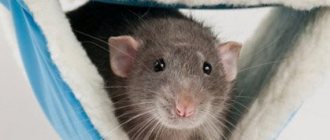- home
- General information
01/06/2019 Hamsters have been bred at home for many decades. These nimble, funny animals have retained the genetic memory of their wild ancestors. Under certain conditions, just like their freedom-loving relatives, they can be in a state similar to hibernation. How to understand that a hamster is hibernating, how dangerous is it and what to do?
What is torpor and hibernation?
Torpor in hamsters differs from the hibernation of its wild counterparts primarily in the reason that caused this condition. Hibernation among wild brethren is a natural protective reaction of the body to harsh winter conditions.
In pets, the instinct of self-preservation is also triggered, which is expressed in numbness. This is an alternative state to rodent hibernation. It is not difficult to recognize him. Life processes in the hamster’s body begin to work at a slow pace. A zoologist compares this phenomenon to the fact that this is a kind of defensive reaction of an animal, a “standby mode” in order to more easily survive some unfavorable moment.
From the outside it looks very much like the animal has died. The body becomes cold, the muscles are “linked”, the hamster does not react to external stimuli.
Seeing your pet in this form, you shouldn’t be scared or make hasty conclusions, but carefully check: is he breathing, is his heart beating? To determine that a Syrian hamster is hibernating, you need to be patient. The heart makes only 4 beats per minute. You can hear this by bringing the animal close to your ear. Breathing is also weak and almost imperceptible.
What to do with a dead hamster. How to bury a pet
You can bury the deceased hamster yourself on your own property or in the courtyard of an apartment building or in a park, but not in a flowerbed or in the front garden, but in a place that is unlikely to be dug up.
It is a little consoling that for these animals there is no need to dig a deep hole; a depth of one bayonet of a shovel will be enough.
There are also special agencies that provide a full range of funeral services for pets. They have special cemeteries where they can bury pets, can carry out cremation, and are also ready to completely take on all the necessary difficulties that may arise during the funeral.
These services are undoubtedly quite expensive, but if you would like to be able to visit your pet’s grave from time to time, this is the best option available.
In conclusion: carefully monitor the health of your charges, provide them with the best care and living conditions, treat them with love, and then they will definitely delight you with their presence in your home for much longer.
https://kotsobaka.com/gryzuny/homjak-umer.htmlhttps://localvet.ru/veterinariya/gryzuny/gibel-homyakahttps://pets2.me/bok/1408-chto-delat-esli-homyak-umiraet. html
The rhythm of life of wild animals
The life rhythm of wild rodents is subject to seasonality. In the summer, they intensively carry supplies into their burrows in their cheeks, preparing for winter. They feel the cold approaching, when there will be no greenery in the fields, and low temperatures will not allow them to leave the mountain.
Hamsters hibernate, well capturing the moment when it becomes necessary. The rodent goes into its home, it has a cozy nest, and next to it there is a pantry with supplies and settles down to sleep. A wild animal approaches this state prepared - having eaten and gained subcutaneous fat.
In his sleep, he breathes less frequently, his heart beats slowly, and his metabolism goes into economy mode. The animal's body temperature drops by 1–2℃. A hibernating hamster feeds on the fat layer fed during the warm season. From time to time the animal comes out of this state, eats and falls asleep again. This rhythm of life in winter allows him to survive the “hungry” season without problems. Usually there is more than enough food in the hamster’s pantries for even three winters.
Hibernation in hamsters continues until the onset of warm days. In the spring, when the ambient temperature rises, hamsters come out of “saving mode.” But before the day it will be possible to get food in the fields, a month or two must still pass. Hamsters spend this period in the hole, finishing up their supplies. Females come out even later, closer to the time when mating season begins.
In the wild, it is not so easy to see a hamster, because they are nocturnal hunters. Hamsters sleep during the day and come out of their holes at night to get supplies. This way they feel more protected. Closer to dawn, the animal goes into its hole, eats and falls asleep until the next “night shift”. Domestic hamsters also sleep during the day.
Other diseases
If your hamster is breathing frequently "out of the blue" without being scared or tired, this indicates respiratory or heart failure.
Pneumonia
You need to listen to the breathing of a tiny animal - wheezing, gurgling, snuffling indicate problems with the lungs. If you've recently had a runny nose and your hamster has become lethargic and reluctant to eat, it could be pneumonia (pneumonia). The animal simply cannot breathe, so it tries not to move and freezes in one place.
Treatment consists of antibiotic therapy - for small rodents, Baytril 2.5% is traditionally used at a dose of 0.4 ml per 1 kg of weight (for a dzhungarik weighing 50 grams, this is 0.01 ml). Injections are given subcutaneously 1 time a day for 10-14 days.
Agony
If a hamster lies motionless with his eyes open and breathes heavily, and before that he was sick for several days, then he dies. There is no way to help a rodent in agony; even an experienced veterinarian can only end the suffering by euthanizing the animal.
Consider whether your hamster has wet tail fur (a sign of diarrhea), a sudden increase in abdominal contour, or sudden weight loss. Hamsters have a very fast metabolism, so they cannot be sick for a long time: without proper treatment or in case of severe problems, they “burn out” in a few days.
Decorative hamsters have fragile health, and yet the animal can live its entire short life without getting sick. To do this, you just need to follow simple feeding and maintenance rules. In case of unforeseen circumstances, you need to find out in advance where to go for an appointment with a rodent - general practitioners will not be able to provide qualified assistance. And do not despair if the hamster lies and does not move, but breathes: perhaps all is not lost.
The hamster lies motionless: reasons 4.8 (95%) 12 votes
Do pet hamsters hibernate?
Families that keep rodents as beloved pets often wonder: Do hamsters hibernate in winter? Considering that the ambient temperature and the length of daylight hours are decisive factors, it is logical to assume that the hamster will feel the onset of cold weather even in the cage.
Yes, indeed, for some time the hamster can go into a state of torpor. This will not be expressed as in wild animals - with periods of waking up and replenishing supplies, but temporarily, for several hours or days. It happens that a rodent goes into hibernation for a week or two.
Habitual sleep pattern
At its core, the hamster is a nocturnal animal, both at home and in nature. At night he is awake, and during the day he sleeps.
An animal can easily sleep all day, but when night comes, he will begin to actively spin the wheel, climb in mazes and restore order in the cage. Many owners of a cute animal are not happy with this, so they try to teach it to sleep at night.
This is very difficult to do. In addition, if the owner does not allow the pet to sleep during the day, this will unsettle him. Therefore, it is better not to interfere with his usual sleep pattern.
Symptoms of torpor in hamsters
Wild hamsters hibernate during the winter to save food for themselves. Domestic rodents do not need to forage for food, but genetic memory can also provide the impetus for seasonal torpor.
Every hamster owner should know these symptoms to avoid making mistakes.
Signs of a hibernating hamster:
- the animal is completely immobilized;
- does not react in any way to touch or loud noise;
- the body is cold, frozen;
- heartbeat and breathing are very difficult to hear.
The hamster remains in a stupor for several hours or even several weeks. It is necessary to check the animal’s breathing from time to time by holding a mirror to its nose, which should fog up.
All breeds are dormouse!
The most popular types of hamsters for home breeding include:
- Syrian;
- Djungarian;
- long-tailed;
- ordinary;
- angora.
Albino.
There are also so-called albino hamsters. These are also very often kept at home. Although this is not a breed, it is a biological feature of a living organism - the absence of dark pigmentation. These hamsters are pure white with a pink nose and pink eyes. All these hamsters are capable of falling into suspended animation, since this was typical for their ancestors under natural conditions. By the way, it has been noticed that most often hibernation at home “happens” to Syrian hamsters.
What causes hibernation at home?
What is normal for wild hamsters is not always good for pets. There must be good reasons for a dwarf hamster or another representative of domestic hamsters to hibernate. And they are usually unfavorable:
- The cold in a house or apartment provokes a state of suspended animation. When the temperature in the room where the pet is located stays at 15 degrees for a long time or drops below, there is a very high probability that the animal will hibernate. At 10℃ this is inevitable.
- The animal associates darkness with the onset of winter. Staying in the sun is also harmful for the animal, but the curtains in the room must be opened in the morning so as not to shorten the daylight hours. Otherwise, it will mean autumn for the hamster.
- Improper nutrition with insufficient amounts of vitamins and microelements results in lethargy of the rodent. A constantly sleepy or sleeping hamster is a “bell” that not everything is normal. If the hamster is not provided with adequate food, its body will react with suspended animation.
- Stress often causes hibernation. Numbness helps the animal cope with the excitement it has experienced. Stress is, first of all, the fear experienced when a cat or dog appears next to a cage, the cage falls, or a very loud, sharp, unexpected sound.
It happened that the animal fell into a state of suspended animation after a long journey. Moreover, this can happen to an animal at any time of the year.
Walk
When you see a hamster gnawing doomedly at the bars of its cage, does your heart clench with pity? Do you feel that your hamster needs freedom, so every evening you let him out for a walk and watch with affection as he gets stuck under the closet or falls from the curtain? Whether or not to let your hamster out for a walk is up to you, but the best thing you can do is buy a ball for walking or fence off a safe area with enclosures. Believe me, there is no hole that a hamster cannot fit through. Although it seems to you that your pet is a fat, overfed hog, in fact, at the right time he can become very flat, so it is better not to let him roam freely. Otherwise, you risk finding it on the cabinet, in a pot of fish, or, God forbid, in your underwear drawer. Yes, a hamster can do it.
Should I wake you up or not?
When it becomes clear that the pet is in a daze, there is no need to immediately bother him or try to wake him up. First you need to understand the reasons for hibernation.
The main reason that could be is the cold. However, under natural conditions, hamsters approach the cold period prepared - they have an “extra” layer of fat from which they feed. A pet can die in its sleep from exhaustion. You need to wake him up, but first adjust the temperature in the room. To wake a hamster from hibernation, you need to pick it up and warm it with your palms and breath. This will take about an hour. If you don’t have time to warm your baby in your palms, under no circumstances should you resort to using heaters and lamps. The animal will die from intense heating. You can build him a warm cotton nest, and put a warm heating pad under the cage (or nearby), from which the heat will spread gradually.
If the cause of torpor is stress, the hamster should be woken up after 24 hours. During this time he will have time to come to his senses. They wake him up in the same way - by enclosing him in their palms and stroking him.
You need to put “sweets” in the feeder so that the pet becomes interested in them, and he loses the desire to hibernate again.
Why does a hamster sleep constantly (all day and night)
It is also possible that the duration of sleep increases up to 20–22 hours. This can happen due to several reasons, some of which are due to environmental conditions, and some of which are due to the condition of the hamster itself.
Here is a list of the most likely reasons leading to a significant increase in the sleep duration of these animals:
the pet you purchased is too old (more than 1–1.5 years old); the animal is exposed to excessive stress, for example, due to constantly pestering children or due to excessive interest in it from other pets; the animal eats irregularly, in insufficient quantities, or its diet has a pronounced imbalance of the protein-energy component; there is not enough light in the room in which the animal’s cage is located, but it must be remembered that the presence of not direct, but rather diffuse, sunlight is important; the room has a constantly low temperature, which significantly slows down the metabolic processes occurring in the animal’s body and, accordingly, increases the duration of its sleep; The hamster's cage is not properly equipped: first of all, we are talking about the lack of a variety of toys, labyrinths and wheels that allow these animals to receive the necessary boost of energy during intense physical exercise.











